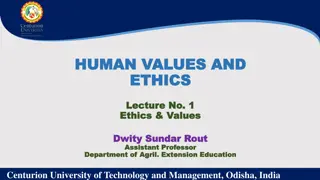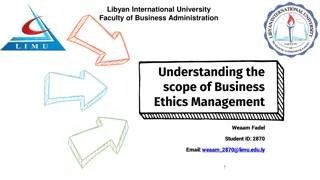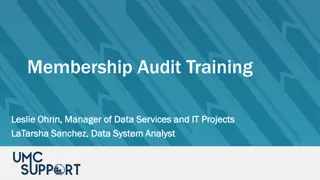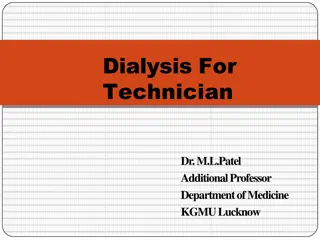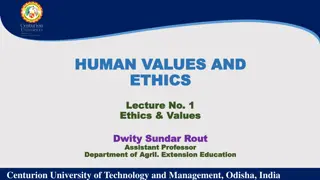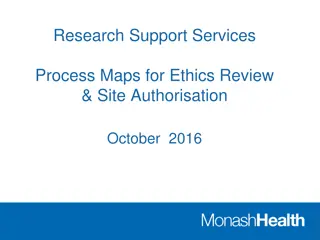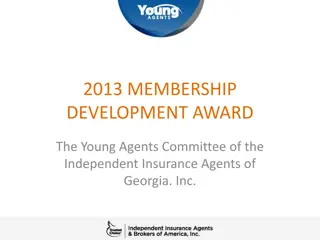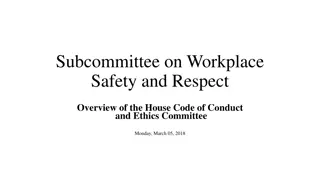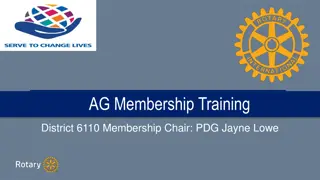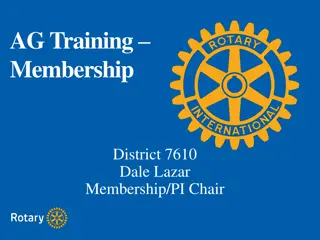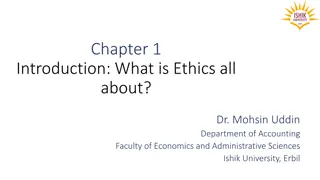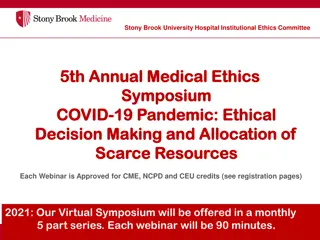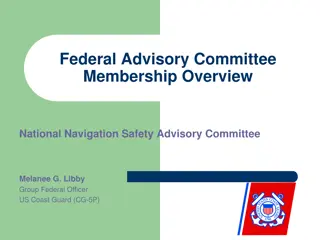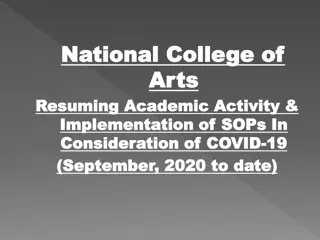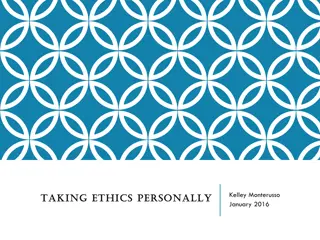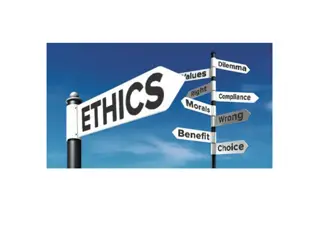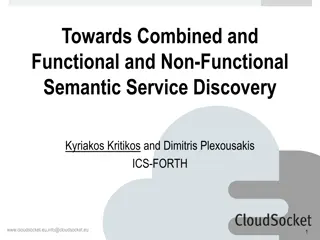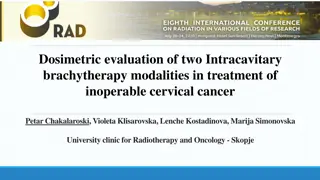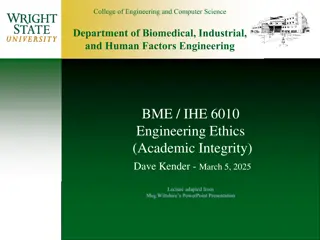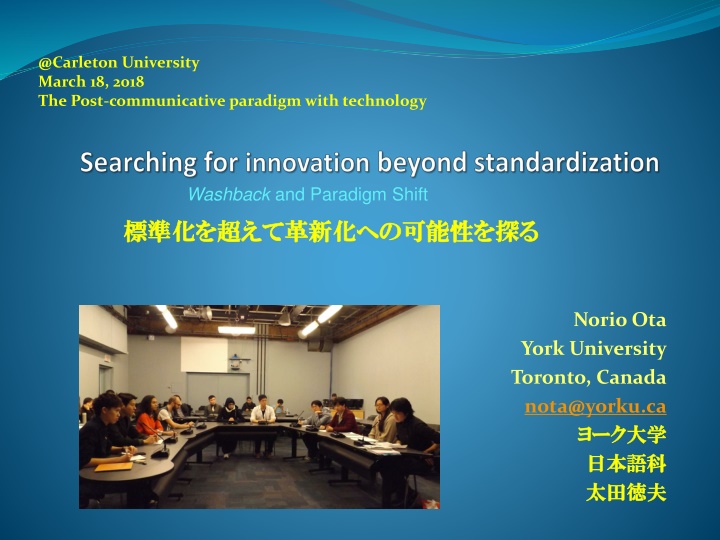
Functional Modalities of Ethics Review Committee: Membership, Training, SOPs, and Review Process
This content explores the composition, training requirements, SOPs, submission protocols, ethical review types, criteria, decision-making process, and monitoring aspects of an Ethics Review Committee. It emphasizes the importance of multidisciplinary membership, ethical guidelines adherence, and proper protocol review for research involving human participants.
Download Presentation

Please find below an Image/Link to download the presentation.
The content on the website is provided AS IS for your information and personal use only. It may not be sold, licensed, or shared on other websites without obtaining consent from the author. If you encounter any issues during the download, it is possible that the publisher has removed the file from their server.
You are allowed to download the files provided on this website for personal or commercial use, subject to the condition that they are used lawfully. All files are the property of their respective owners.
The content on the website is provided AS IS for your information and personal use only. It may not be sold, licensed, or shared on other websites without obtaining consent from the author.
E N D
Presentation Transcript
@Carleton University March 18, 2018 The Post-communicative paradigm with technology Washback and Paradigm Shift Norio Ota York University Toronto, Canada nota@yorku.ca
State of affairs surrounding university education Sweeping Neo-liberal policies across universities Neoliberalism Free market economy Top-down decision making Less importance on SS, Huma and languages Commodification of education 3/18/2018 Searching for innovation beyond standardization 2
Washback hypothesis Narrow definition: Effects of testing on learning and teaching Washback hypothesis Wide definition Narrow definition Unintended Intended Unintended Positive Negative Positive Negative Negative Positive 3/18/2018 Searching for innovation beyond standardization 3
Washback: narrow definition CURRICULUM INSTRUCTIONAL MATERIAL TEACHING STRATEGY washback TESTING LEARNING ASSESSMENT 3/18/2018 Searching for innovation beyond standardization 4
Washback: wide definition Curriculum Instructional Assessment materials Learning Teaching strategy Testing 3/18/2018 Searching for innovation beyond standardization 5
Module & Synergy Speaking Structure Reading Vocabulary Listening Culture Writing 3/18/2018 Searching for innovation beyond standardization 6
What technology has made possible Self-study materials Modular synergy approach Online testing Technology Distance education 3/18/2018 Searching for innovation beyond standardization 7
Essence of new paradigm Reliance on a learner s self-study Freeing up time for in- class communica tive activities Authoring instructio- New paradigm nal materials Empowering teachers and learners 3/18/2018 Searching for innovation beyond standardization 8
Paradigm shifts in TJFL Modular-Synergy approach No core textbook Authoring instructional materials for specific purposes Each module has its own syllabus. Modules enhance synergistic effects. Developing materials to enhance synergy Personalizing instructional materials Developing internally condensed materials for short study period Communicative-empathic approach Content-based language learning Language learning for university education Taking advantage of extra curricular activities Increasing accessibility via the Internet Technology Enhanced Learning (TEL) Multi-dimensional involving distant learners Empowering language professionals and learners 3/18/2018 Searching for innovation beyond standardization 9
Japanese program @ YorkU Program web site http://buna.arts.yorku.ca/ jp1000 http://buna.arts.yorku.ca/japanese/jp1000.html jp2000 http://buna.arts.yorku.ca/japanese/jp2000.html jp3000 http://buna.arts.yorku.ca/japanese/jp3000.html jp4000 http://buna.arts.yorku.ca/japanese/jp4000.html Self-study materials Video-recorded lectures, seminars and some tutorials jp1000_lecture Reading materials with pop-ups and sound files jp2000_reading jp3000_reading jp4000_reading Interactive exercises on structures jp1000_interactive Interactive reading comprehension materials jp1000_reading Sino-Japanese characters (Kanji) writing instructions jp1000_kanji Listening recognition and comprehension jp1000_listening Videos for understanding culture and society jp1000_video 3/18/2018 Searching for innovation beyond standardization 10
Washback to create differences Self-study materials for reading, listening, writing , speaking, structure, and vocabulary. Use of Internet films, games, video-clips, anime, Use of laptops and tablets Use of social network Excellence in teaching Intensive orientation and regular meetings Exploring further possibilities to increase sophistication of online tests Better communication with students High performance Higher grading scheme Increasing use of Japanese In-depth understanding Advanced activities such as web presentation, debate, interview, resume writing. New classroom environment Multi-dimensional use of video-conferencing Video-streaming for external participation Video-recording for review Expecting to have smart-classes Extracurricular activities Japanese Language Proficiency Test Ontario Japanese Speech Contest Exchange programs Japan Exchange and Teaching (JET) Summer internship program Future plan New evaluation rubric and portfolio (in preparation) Co-op program (implemented in 2015-6) Summer in Japan project (in preparation) New honours minor degree program in Japanese Studies (commenced in the fall of 2014) 3/18/2018 Searching for innovation beyond standardization 11
A case of intended washback: oral tests Creating own script Evaluation based on content, organization, presentation, pronunciation, vocabulary and structure Memorizing and acting out the script SKIT Working with different partners every time 3/18/2018 Searching for innovation beyond standardization 12
Unintended washback: online testing using Moodle Moodle was chosen to put first year language tests on line for the following reasons. Free Open source customizable Non-proprietary User-friendly Ease of installation Flexible Language support Modular & Comprehensive Language teaching professionals are often reluctant in developing online tests due to the following restrictions. Challenges for online testing for languages limited types of questions lack of analytical tools (natural language parsing) lack of qualitative evaluation lack of evaluation for communicative competence security issues 3/18/2018 Searching for innovation beyond standardization 13
Implementation and objectives of online testing Online testing is NOT comprehensive Online testing is to access each learner s knowledge and recognition of: Vocabulary Expressions Conjugations Sentence structures Basic kana characters and basic sino-Japanese characters (kanji) Simple context (communicative understanding) Sociolinguistic and pragmatic aspects Developing tests Transforming paper-based tests into web-based versions Modifying types of questions Developing new types of questions Reviewing students answers and modifying possible answers Readjusting answers to introduce partial marking system Developing a questionnaire for students feedback Sample: jp3000 test 2 3/18/2018 Searching for innovation beyond standardization 14
Positive washback effects Students: Students become familiar with the no-textbook approach. Students become autonomous learners. Everyone uses a mobile device to access to the online materials to maximize their study time. Learning style has become flexible and dynamic. In-class activities have become more communicative, which creates more relaxed environment. The level of satisfaction has increased. Students expectations on their proficiency have become higher. Students pass higher levels of the JLPT. Students can function better in Japan. Instructors: Can pay more attention to macro aspects. Can spend more time for communicative activities in class. Can free up their marking time for other activities. Can become more autonomous and innovative teachers. 3/18/2018 Searching for innovation beyond standardization 15
Negative washback effects Students: tend not to study in depth and detail. do not necessarily cover self-study materials. depend too much on mobile devices mobile device dependency syndrome. tend to use web content as resource not as object to learn. tend not to review materials during breaks. do not show expected results. do not know how to study within such a framework. tend to become lost in various instructional materials. cannot handle self-study materials. Instructors: very challenging tend to lose focus Intensive orientation is necessary for new comers. lags behind in technological advancement. tend to lose flexibility and become less innovative. time-consuming 3/18/2018 Searching for innovation beyond standardization 16
Powerful influence of standardization Paradigm shifts and language education Grammar-Translation Method Direct Method Audiolingual Approach Cognitive-Code Approach Functional-Notional Approach Natural Approach Communicative Approach There have been other approaches proposed and practiced. The Silent way Suggestopedia Community Language Learning Total Physical Response
Paradigm shift by Jacobs & Farrel (2001) Positivism Post-Positivism Emphasis on parts and decontextualization Emphasis onwhole and contextualization Emphasis on separation Emphasis onintegration Emphasis on the general Emphasis on thespecific Consideration only of objective and the quantifiable Consideration also ofsubjective and the non- quantifiable Reliance on experts and outsider knowledge-- researcher as external Consideration also of the "average" participant and insider knowledge--researcher as internal Focus on control Focus onunderstanding Top-down Bottom-up Attempt to standardize Appreciation of diversity Focus on the product Focus on theprocessas well
Innovation Abolishing the textbook-centred approach Content oriented Self-study Personalized Attractive Creative Creating localized materials Testing Assessment Curriculum Materials Activities
Innovation (cont.) Creating truly autonomous learners Self-study material Internet Game, anime, manga Educationalizing language education Personal contact Consultation Advising Group study Involvement Globalizing education Technical cooperation across borders project in Cuba and Korea Use of technology
Use of technology On technology, Larsen-Freeman & Anderson (op. cit.) states: The ongoing development of technology is another of those external influences that has had a major impact in the field, and this is likely to increase in the future. One of the external forces, IT, relieves teachers and learners from the constraints by standardization. Technology has revolutionalized language education in various ways. Easier to create instructional materials by teachers Can continue to modify them on demand Can adopt the modular-synergy approach to enhance language acquisition Can disseminate various materials much more easily via the Internet Increase accessibility to the materials Can encourage teachers to adopt critical pedagogy more easily Can introduce local exigencies
Global level: JLPT new framework Old JLPT vs. New JLPT Common European Framework of Reference for Languages (CEFR) American Council on the Teaching of Foreign Languages (ACTFL) Revised standard Levels JF Standard for Japanese-Language Education 2010 3/18/2018 Searching for innovation beyond standardization 22
Standardization as a lowest common denominator approach? American Council on the Teaching of Foreign Languages Inc. (1996) Standards for Foreign Language Learning Preparing for the 21stCentury National Standards for Foreign Language Education - A Collaborative Project of ACTFL, AATF, AATG, AATI, AATSP, ACL, ACTR, CLASS and NCJLT-ATJ Council of Europe (2001) Common European Framework of Reference for Languages: Learning, Teaching Assessment Japan Foundation (2010) JF Standard for Japanese- Language Education 2010 ACTFL Proficiency Guidelines 2012
JLPT: Pros Adopting the CEFR as the standard Reference to ACTFL and other framework Creating JF Standard for Japanese-Language Education Can-do statements Hoan (2010) project for creating conversation tests based on the JF Standard Rubrics Portfolio Using the new JLPT to produce positive intended washback in Japanese language education in the world The developing frame of reference based on Can-do statements is more teacher and learner friendly and helpful in modifying teaching and learning strategies, shifting the focus of curriculum into more communicative abilities of learners. 3/18/2018 Searching for innovation beyond standardization 24
JLPT: Cons Frame of reference and its implementation: Washback process is a slow one, and it would take a long time for language instructors to not only adopt the essence of the JF Standard and CEFR but also implement it into teaching, learning, instructional materials, classroom activities and tests. The Japan Foundation has a massive task in revamping all the existing instructional materials it has published and its teacher training/education projects. Can-do, for example, is repeated like a mantra to solve all the problems, but it is a mere cover term that sums up an integral part of the already existing curricula based on the communicative approach in many programs. It is not a cure-all panacea. How to help learners to achieve various communicative abilities is the real work. In order to design a course, develop course materials and teaching methodology with a different paradigm, one requires in-depth study and research in SLA and its related fields. Unfortunately, most language instructors do not have such background and there do not appear to be much expertise within those who have been developing this new paradigm either. The end result may be a mediocre standardization , which we already observed within the previous paradigm , namely generic approach and textbook-oriented framework. 3/18/2018 Searching for innovation beyond standardization 25
JLPT: Cons (cont.) The claim that the new version of the test should be able to measure test takers communicative ability is not tenable as long as the test format reading, writing and listening comprehension, remains the same, although the combinations have been changed. Introducing Can-do helps to modify the focus of the test to more communicative ability, but the types of questions do not appear to be much different. There was no preparation period for test takers or language instructors. As mentioned earlier, it is not fair to assess test takers proficiency when they are not trained/educated in a similar environment where communicative ability is the main focus. The initial strict secrecy policy on test questions and assessment procedures have been already compromised with the publication of practice manuals very similar to the ones for the previous tests. Test takers would continue to prepare specifically for passing the tests as they did before. Evaluation method, criteria and procedure are not easy to understand and have not been proven fairer than the direct raw point system. CEFR is a guideline and a framework. Implementing it into JLPT requires a lot of time. The use of the term standardization is misleading. I do not think the Japan Foundation should create the norm for Japanese language education in the world. We need more diversity and new creative approach depending on the location, background, learners, and interests. The Japan Foundation appears to continue politicizing Japanese language education. 3/18/2018 Searching for innovation beyond standardization 26
Conclusion It is not easy to quantify the washback effects, since they are more related with quality factors of language teaching and learning. To use washback effects positively to implement a new paradigm and strategy is an important shift in testing and measurement in a regular course work, where all the modules complement and enhance each other to secure the quality education and expected results. On the other hand, a high-stake general proficiency test such as JLPT can influence the general Japanese language education in the world, but with the traditional format multiple choice paper tests on reading, structure, vocabulary, writing and listening comprehension, the intended effects might be difficult to achieve. While the Japan Foundation s efforts and leadership in revamping Japanese language education in the world are much appreciated together with the publication of the standard , there exist discrepancies between the intended goals and objectives and the actual tests. The washback effect by tests alone is rather limited and the results may be disappointing. Due to the Japan Foundation s hegemony over the Japanese language education in the world, there is a serious danger that the new JLPT would set another mediocre standard that language instructors are expected to conform to. The major effort should be made in encouraging language professionals to develop holistic and dynamic language programs with more diversity and creativity at a local level to give positive washback to the Japan Foundation rather than being dictated by its standard . 3/18/2018 Searching for innovation beyond standardization 27
Conclusion (cont.) From the discussion above, it is clear that the trend of standardization tends to stifle and stagnate language education. In order for language education to survive as an integral discipline in the university education, language professionals must adopt critical pedagogy and the post-positivism paradigm with rigour for further innovations suggested in this paper. I have mentioned this criticism elsewhere, but I wish organizations like the Japan Foundation, which has global influence on the Japanese language education would focus more on innovation rather than standardization and give support on localized projects and initiatives. Applying the JF standard to teaching is NOT what true language professionals are expected to do. It is important to note that the cycle of innovation and standardization, which can be observed in every field, should be reexamined. Do we have to go through the stage of standardization to the next level of innovation? Isn t the standardization for maintaining the lowest common denominator? We must scrutinize the phenomena of globalizing Japan by the world standard. It may kill local ingenuity, originality, and creativity. In my 47 years of teaching of Japanese as a Foreign Language experience now I know clearly what I have been up against STANDARDIZATION. I have been encouraging younger colleagues to be innovative and risk-takers not to be influenced by the traditional approach to language teaching and learning, but there appears to be strong trend to conform to standard , which is easier for both learners and teachers, but the emergence of excellent self- taught learners indicates that standardization is not the route for excellence in language proficiency.
References: Akbari, R (2007) Reflections on reflection: A critical appraisal of reflective practices in L2 teacher education , System 35: 192-207. Alderson, J. C. & Banerjee, J. (2001) Language testing and assessment (Part 1), Language Teaching , 34, Cambridge University Press, 213-236. _______________________(2002) Language testing and assessment (Part 2), Language Teaching , 35, Cambridge University Press, 79- 113. American Council on the Teaching of Foreign Languages Inc. (1996) Standards for Foreign Language Learning Preparing for the 21st Century National Standards for Foreign Language Education - A Collaborative Project of ACTFL, AATF, AATG, AATI, AATSP, ACL, ACTR, CLASS and NCJLT-ATJ . https://www.actfl.org/sites/default/files/publications/standards/1996%20National%20Standards%20for%20FL%20L%20Exec%20Sum mary.pdf ______(2012) ACTFL Proficiency Guidelines 2012 Council of Europe (2001) Common European Framework of Reference for Languages: Learning, Teaching Assessment. http://www.coe.int/t/dg4/linguistic/Source/Framework_EN.pdf Chakrakodi, R. (2011) The washback effect, Deccan Herald, Thursday, 26 May 2011 (http://www.deccanherald.com/content/151593/washback-effect.html). Cheng, L. (2000) Washback or Backwash: A Review of the Impact of Testing on Teaching and Learning, Educational Resources Information Centre (ERIC), U.S. Department of Education. Chen, L.M. (2006) Washback effects on curriculum innovation, Academic Exchange Quarterly, Cheng, L, Watanabe, Y. & Curtis, A. (eds.)(2004) Washback in Language Testing: Research Contexts and Methods, Laurence Erlbaum & Associates. Council of Europe (2001) Common European Framework of References for Languages: Learning, Teaching and Assessment (http://www.coe.int/t/dg4/linguistic/Source/Framework_EN.pdf). Freeman, Donald (2002) The hidden side of the work: Teacher knowledge and learning to teach , Language Teaching 35: 1-13. Jacobs, George M. & Thomas S C Farrell (2001) Paradigm Shift: Understanding and Implementing Change in Second Language Education , TESL-EJ: Vol.5. No.1. A-1, April, 2001. http://www.zait.uni-bremen.de/wwwgast/tesl_ej/ej17/a1.html Japan Foundation (2010) JF Standard for Japanese-Language Education 2010 (http://jfstandard.jp/pdf/jfs2010_all.pdf). Kumaravadivelu, B. (1994) The postmethod condition: (E)merging strategies for second/foreign language teaching , TESOL Quartery 28/1: 27-48. http://bkumaravadivelu.com/articles%20in%20pdfs/1994%20Kumaravadivelu%20Postmethod%20Condition.pdf 3/18/2018 Searching for innovation beyond standardization 29
References (cont.) Larsen-Freeman, Dianne (1991) Research on language teaching methodologies: A review of the past and an agenda for the future in K. de Bot, R. Ginsberg, and C. Kramsch (eds.) Foreign Language Research in Cross-Cultural Perspective, 119-32, Amsterdam/Philadelphia: John Benjamins Publishing Co. _____________ & Donald Freeman (2008) Language moves: The place of foreign languages in classroom teaching and learning , Review of Research in Education 32: 147-86. _____________, Dian & Marti Anderson (2013) Techniques and Principles in Language Teaching 3rd edition, Oxford University Press. Long, Michael H. (2009) methodological principles for language teaching in M. Long and C. Doughty (eds.) The Handbook of Language Teaching, 373-94, Malden, MA: Wiley-Blackwell. Okamoto, S. (2010) Common European Framework of Reference suggests the sociolinguistic competence in Teaching Japanese as a Foreign/Second Language, 85-98. Ota, N. (2009) Synergy, Empathy and Communicative Approach , 2009 Japan Studies Association of Canada Conference, University of Lethbridge, Lethbridge, Alberta, Canada, October 1-4, 2009. ______ (2010) Textbook dominance in foreign language teaching and learning, Power & Knowledge Conference, Tampere, Finland, September 6-8, 2010. ______ (2011) Paradigm shift and washback in TJFL, Japan Studies Association of Canada Annual Conference, Halifax. ______(2012) Power of Washback and Differences in Foreign Language Teaching and Learning, Power and Difference International Conference, Tampere, Finland, August 27-29, 2012 ______ (2014) Washback and paradigm shift the post-communicative paradigm with technology , the 12th Hawaii International Conference on Arts and Humanities, Honolulu, Hawaii, January 10-13, 2014. ______ (2016) Washback and Paradigm Shift: The Post-communicative paradigm with technology A new initiative in Japanese language education in Canada , invited talk in Japanese at Korea University, Seoul, Korea, July 15, 2016. ______ (2016) Standardization vs. innovation in language education, Japan Studies Association of Canada Annual Conference, Vancouver, October 13-16, 2016. Link: http://www.jsac.ca/jsac_web_pub/jsac2016_pub_global.pdf Paradowski, Michael B. (2007) Comparative linguistics and language pedagogy: concise history , https://www.academia.edu/2400983/Comparative_Linguistics_and_Language_Pedagogy_Concise_History_and_Rationale Prabuhu, N.S. (1992) The dynamics of the language lesson , TESOL Quartery 26/2: 225-41. Richards, Jack C. & Theodore S. Rodgers (2014) Approaches and Methods in Language Teaching: Third edition, Cambridge University Press. _______________ & Theodore S. Rodgers (2014) Approaches and Methods in Language Teaching: Third edition, Cambridge University Press. Savignon, Sandra J. (2007) Beyond communicative language teaching: What s ahead? , Jounal of Pragmatics 39: 207-20. Wills, John S.& Sandholtz, Judith Haymore (2009) Constrained Professionalism: Dilemmas of Teaching in the Face of Test-Based Accountability , ERIC, Teachers College Record, v111 n4 p1065-1114 2009. 3/18/2018 Searching for innovation beyond standardization 30

